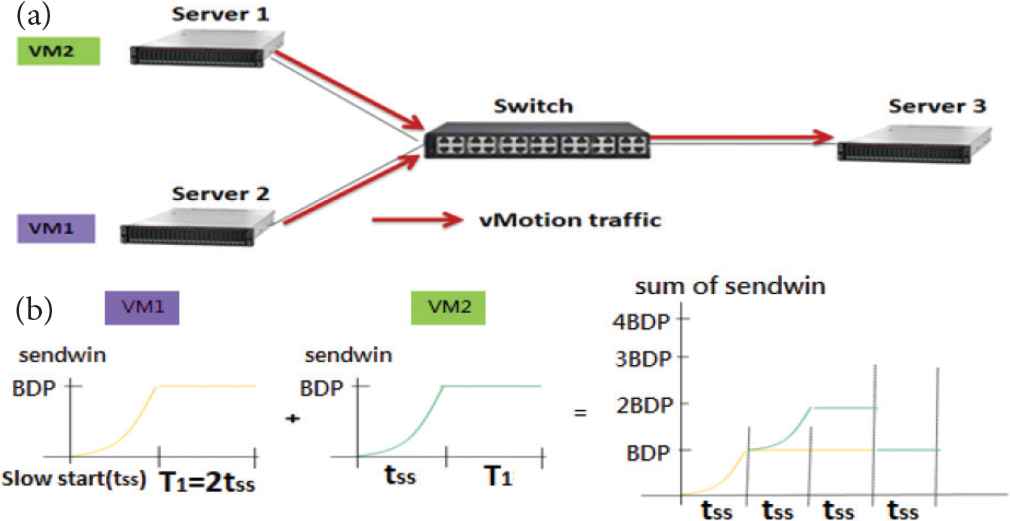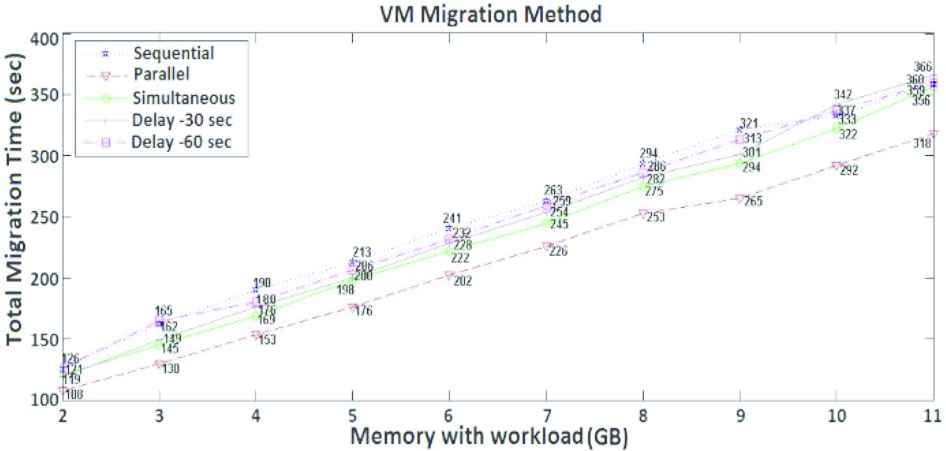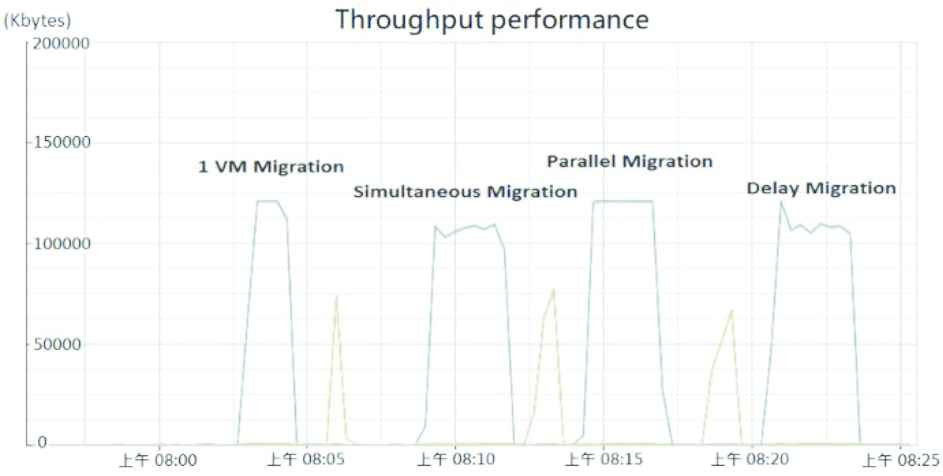Selection Strategy for VM Migration Method
- DOI
- 10.2991/jrnal.k.190602.003How to use a DOI?
- Keywords
- VM migration; sequential; delay; parallel; simultaneous
- Abstract
Virtual machine (VM) live migration occurs frequently in cloud environments. When it is necessary to migrate many VMs, minimizing the migration time is an important concern. Thus, choosing an appropriate strategy to perform VM migration is essential. Accordingly, this paper discusses the advantages and disadvantages of four different migration methods and evaluates their respective migration times and throughputs.
- Copyright
- © 2019 The Authors. Published by Atlantis Press SARL.
- Open Access
- This is an open access article distributed under the CC BY-NC 4.0 license (http://creativecommons.org/licenses/by-nc/4.0/).
1. INTRODUCTION
Virtual machine (VM) migration plays a critical role in cloud computing in satisfying user demand for computing resources while simultaneously meeting the needs of the operator for energy savings, load balancing, periodic maintenance, and so on. VM migration can be performed using four different methods, namely sequential, delay, parallel, or simultaneous. In sequential migration, migration of a VM is performed only once the migration of the previous VM on the same server has been completed. In delay migration, the VMs are located on different servers and a small delay is introduced between their migration. In parallel migration, multiple VMs located on the same physical server are migrated at the same time. Finally, in simultaneous migration, VMs located on different physical servers are migrated at the same time. In practice, the migration times of the four methods may vary widely. Thus, the choice of an appropriate migration method is essential to minimize the total migration time under different VM memory loads, migration link bandwidths, page dirtying rates, and so on.
The main contributions are as follows:
- (1)
The study has analyzed the migration time and throughput performance of four different VM migration methods (sequential, delay, parallel, and simultaneous).
- (2)
The study has proposed a selection strategy for VM migration method under different link bandwidth.
- (3)
The study has experimented the variation of the total migration time with the VM memory load under each of the considered migration methods.
2. BACKGROUND AND RELATED WORK
2.1. VM Migration Techniques
Virtualization platforms generally utilize either a pre-copy live migration approach [1,2] or a post-copy live migration approach [3,4]. Of the two methods, the pre-copy method results in a shorter downtime, while the post-copy method results in a shorter total migration time. In Akoush et al. [5] and Elsaid et al. [6], the authors showed that the overall migration time for Stages 0–5 of the pre-copy method comprises four components, namely the Pre-Migration Overhead (Stages 0 and 1), the Stage 2 Overhead, the Stage 3 Overhead, and the Post-Migration Overhead (Stages 4 and 5). Among these components, the Stages 0/1/4/5 overhead time is static but not constant. Consequently, under the same VM migration conditions, the overhead times of the pre- and post-copy migration methods are slightly different.
2.2. Migration Performance Indicators
Common migration performance indicators include the total migration time, the migration down time, and the total number of VM migrations. The total migration time measures the elapsed time between the start of the first VM migration process and the end of the final VM migration process. Akoush et al. [5], Elsaid et al. [6], and Salfner et al. [7] investigated the effects of various factors on the total migration time, including the migration link bandwidth, the frequency of dirty memory pages, the VM memory size, and so on. The migration down time measures the time for which service is interrupted during the migration process, and should be minimized in order to maintain user satisfaction. Finally, the number of VM migrations indicates the total number of VMs migrated, and should be reduced to the minimum number possible to minimize the impact of the migration process.
2.3. TCP Window Size
Virtual machineware [8] prescribes the use of the transmission control protocol (TCP) to establish a connection for VM migration and transmit the corresponding migration traffic. TCP is a synchronous transmission protocol with good reliability and completeness. The TCP window size used to transmit the migration packets is assigned a minimum value of Congestion Window (CWND), receiver window (RWND), i.e., sendwin = min(cwnd, rwnd). Phanishayee et al. [9] presented a scheme for lowering the value of slow start threshold (ssthresh) in order to enter the congestion avoidance stage early. However, the system suffered an insufficient startup problem accordingly. Osada et al. [10] considered a serial transfer process rather than parallel server request units (SRU) transmissions. However, the method resulted in a low bandwidth utilization rate during the slow start cycle.
3. VM MIGRATION METHODS AND WINDOW SIZE
3.1. Sequential Method
Figure 1a shows a typical example of the sequential VM migration process. Let bandwidth delay product (BDP) be the product of the link bandwidth and the round-trip time. Assume that VM1 and VM2 have the same memory size and page dirtying rates (i.e., tss + t1 is constant). Furthermore, assume that TCP ssthresh is larger than BDP. Thus, sendwin is equal to BDP in the slow start phase. The sum of sendwin for the two VMs is then obtained as shown in Figure 1b.

(a) Sequential method. (b) Sum of sendwin.
In the sequential migration method, there is no overlap between the migrations of VM1 and VM2, respectively. Consequently, the sum of sendwin in Figure 1b does not exceed BDP. As a result, the throughput is not degraded by overflows at the switch buffer. However, the bandwidth cannot be fully utilized during the slow start phase and the migration overheads of the two VMs cannot be processed at the same time. Consequently, the total migration time is increased. Furthermore, the operator cannot explicitly configure the time at which each VM migration task is to be performed. In other words, the sequential migration method lacks versatility.
3.2. Parallel Method
As shown in Figure 2a, in the parallel migration method, VM1 and VM2 are located on the same server and are transmitted at the same time over a single connection. The sendwin size of each VM is thus reduced to (1/2)BDP. Consequently, the sum of sendwin is equal to BDP, as shown in Figure 2b. It is seen in Figure 2b that t′ss is less than tss. In other words, the parallel migration method improves the bandwidth usage during the slow start phase. In addition, the migration overheads of the two VMs can be processed at the same time. Hence, the total migration time is reduced.

(a) Parallel method. (b) Sum of sendwin.
3.3. Simultaneous Method
Figure 3a illustrates the simultaneous migration method, in which the migrations of VM1 and VM2, which are located on different servers, are executed in a many-to-one communication mode. Assuming that the links between the source servers and the switch have the same bandwidth, the sum of sendwin reaches BDP after just t′, as shown in Figure 3b. Notably, t′ is less than tss. In other words, the migration process results in a long overlap time between the transmissions of the two VMs. Consequently, the switch buffer easily overflows; resulting in packet drops and a significant reduction in the throughput. Thus, the total migration time of the simultaneous migration process is longer than that of the parallel migration process.

(a) Simultaneous method. (b) Sum of sendwin.
3.4. Delay Method
As shown in Figure 4a, the delay migration method is similar to the simultaneous migration method other than for the fact that a short delay is introduced between the migrations of the two VMs. The delay method reduces the overlap time of the multiple TCP connections (see Figure 4b), and therefore smooths the traffic volume and improves the throughput. However, the total migration time is usually much longer than that of the simultaneous migration method.

(a) Delay method. (b) Sum of sendwin.
Table 1 lists the difference of the performance and total migration time in the four approaches.
| Methods | Sequential | Parallel | Simultaneous | Delay |
|---|---|---|---|---|
| Items | ||||
| If the bandwidths of the links between the switch and the servers (sources and destination) are the same | ||||
| Migration overheads processed at the same time | No | Yes | Yes | No |
| Slow start time | tss | t < tss | t < tss | t ≤ tss, if delay time ≥ tss, then t = tss |
| Overlap time of VMs migration | No | Yes, shorter than Simultaneous | Yes, longer than other methods | Yes, delay time = 0, i.e., the same as Simultaneous |
| TCP-Incast | No | No | Yes | Yes |
| Throughput | highest (1st) | higher (2nd) | lower (4th) | low (3rd) |
| Total migration time | longest (4th) | shortest (1st) | shorter (2nd) | short (3rd) |
A comparative analysis table of different VM migration methods
4. PERFORMANCE EXPERIMENTS AND ANALYSIS
4.1. Experiment Environment
Migration experiments were performed using three HP ProLiant DL380 G6 physical servers (two sources and a destination) and hypervisor VMware vSphere 5.5 software (Palo Alto, California, USA). The experiments replicated the network architectures and migration methods shown in Figures 1a–4a. Each VM was configured to have eight virtual CPUs and 14 GB of virtual RAM. Memory testing tool was used to increase the memory loads of the VMs in the range of 2–11 GB. The total migration time of the VMs under different loads was measured.
4.2. Experiment Results
Figure 5 shows the experimental results obtained for the variation of the total migration time with the VM memory load for each of the considered migration methods. The results support the following main conclusions:
- (1)
The migration methods can be ranked in terms of the total migration time (shortest to longest) as follows: Parallel < Simultaneous < Delay < Sequential.
- (2)
For a memory load of 11 GB, the total migration time of the simultaneous method is close to that of the sequential method.
- (3)
The delay method generally results in a longer total migration time than the simultaneous method. However, the performance of the delay method depends on the delay time applied. For example, given a memory load of 11 GB and a delay time of 120 s, the delay method results in a shorter total migration time than the simultaneous method.

Total migration times of different VM migration methods.
Figure 6 shows the throughputs obtained for each of the four migration methods given a VM memory load of 4 GB. The migration methods can be ranked in terms of the throughput performance (high to low) as follows: Parallel ≈ Sequential > Delay > Simultaneous.

Throughputs obtained under different VM migration methods.
4.3. Migration Selection Strategy
Based on the experimental results presented above for the total VM migration time, the following migration selection strategies are proposed:
- (1)
Selection strategy 1: If the switch-server 3 link bandwidth is much higher than that of the source-switch links:
Selection order: Simultaneous → Parallel → Delay → Sequential method.
- (2)
Selection strategy 2: If the bandwidths of the links between the switch and the servers (sources and destination) are the same:
Selection order: Parallel → Simultaneous → Delay → Sequential method.
5. CONCLUSION AND FUTURE WORK
This paper has analyzed the migration time and throughput performance of four different VM migration methods (sequential, delay, parallel, and simultaneous) under different VM memory loads. In general, the results have shown that when the link bandwidth of the migration destination is much higher than that of the source(s), the simultaneous method results in the shortest migration time. By contrast, if the link bandwidth of the migration destination is equal to that of the source(s), the parallel migration method provides the shortest total migration time. In future work, we will continue to study how to improve the throughput performance and total migration time of VM simultaneous migration method.
CONFLICTS OF INTEREST
There is no conflicts of interest.
ACKNOWLEDGMENTS
This work was supported by the Ministry of Science and Technology (MOST), Taiwan under contracts numbers MOST 107-2218-E-006-036- and MOST 107-2221-E-006-140-.
Authors Introduction
Mr. Yan-Ren Chen
 He is a PhD student in the Institute of Computer and Communication Engineering, National Cheng Kung University, Taiwan. He gained his master degrees in the Department of Electronic and Computer Engineering from National Taiwan University of Science and Technology, Taiwan. His interests are resource allocation in Cloud Computing, Broadband Network and Transmission Network.
He is a PhD student in the Institute of Computer and Communication Engineering, National Cheng Kung University, Taiwan. He gained his master degrees in the Department of Electronic and Computer Engineering from National Taiwan University of Science and Technology, Taiwan. His interests are resource allocation in Cloud Computing, Broadband Network and Transmission Network.
Dr. I-Hsien Liu
 He is a researcher fellow in the Taiwan Information Security Center @ National Cheng Kung University (TWISC@NCKU) and department of electrical engineering, National Cheng Kung University, Taiwan. He got his master degrees in the Department of Information Management from National Kaohsiung University of Applied Sciences, Taiwan. He obtained his PhD in 2015 in computer and communication engineering from the National Cheng Kung University. His interests are Cloud security, Wireless Network, Group Communication and Reliable Transmission in Mobile ad hoc networks.
He is a researcher fellow in the Taiwan Information Security Center @ National Cheng Kung University (TWISC@NCKU) and department of electrical engineering, National Cheng Kung University, Taiwan. He got his master degrees in the Department of Information Management from National Kaohsiung University of Applied Sciences, Taiwan. He obtained his PhD in 2015 in computer and communication engineering from the National Cheng Kung University. His interests are Cloud security, Wireless Network, Group Communication and Reliable Transmission in Mobile ad hoc networks.
Mr. Keng-Hao Chang
 He is a M.S. student in the department of electrical engineering, National Cheng Kung University, Taiwan. He was born in Yilan, Taiwan, in 1993. He received the B.S. degree in electrical engineering from National Chung Cheng University, Chiayi, Taiwan in 2016, and the M.S. degree in computer and communication engineering from National Cheng-Kung University (NCKU), Tainan, Taiwan, in 2019.
He is a M.S. student in the department of electrical engineering, National Cheng Kung University, Taiwan. He was born in Yilan, Taiwan, in 1993. He received the B.S. degree in electrical engineering from National Chung Cheng University, Chiayi, Taiwan in 2016, and the M.S. degree in computer and communication engineering from National Cheng-Kung University (NCKU), Tainan, Taiwan, in 2019.
Dr. Chuan-Gang Liu
 He is an associate professor in the department of Applied informatics and Multimedia, Chia Nan university of Pharmacy and Science. He received the BSc degree from the Department of Electrical Engineering, Tam Kang University, in 2000. Then he graduated from the National Cheng Kung University with M.S. and PhD degrees in electrical engineering. His research interests are in the areas of optical networks control, wireless networks, EPON, VANET, network security, cloud computing and TCP performance analysis.
He is an associate professor in the department of Applied informatics and Multimedia, Chia Nan university of Pharmacy and Science. He received the BSc degree from the Department of Electrical Engineering, Tam Kang University, in 2000. Then he graduated from the National Cheng Kung University with M.S. and PhD degrees in electrical engineering. His research interests are in the areas of optical networks control, wireless networks, EPON, VANET, network security, cloud computing and TCP performance analysis.
Prof. Jung-Shian Li
 He is a full professor in the department of electrical engineering, National Cheng Kung University, Taiwan. He graduated from the National Taiwan University, Taiwan, with B.S. in 1990 and M.S. degrees in 1992 in electrical engineering. He obtained his PhD in 1999 in computer science from the Technical University of Berlin, Germany. He teaches communication courses and his research interests include wired and wireless network protocol design, network security, and network management. He is currently involved in funded research projects dealing with optical network, VANET, Cloud security and resource allocation, and IP QoS architectures. He is the deputy director general of National Center for High-performance Computing (NCHC), National Applied Research Laboratories. He serves on the editorial boards of the International Journal of Communication Systems.
He is a full professor in the department of electrical engineering, National Cheng Kung University, Taiwan. He graduated from the National Taiwan University, Taiwan, with B.S. in 1990 and M.S. degrees in 1992 in electrical engineering. He obtained his PhD in 1999 in computer science from the Technical University of Berlin, Germany. He teaches communication courses and his research interests include wired and wireless network protocol design, network security, and network management. He is currently involved in funded research projects dealing with optical network, VANET, Cloud security and resource allocation, and IP QoS architectures. He is the deputy director general of National Center for High-performance Computing (NCHC), National Applied Research Laboratories. He serves on the editorial boards of the International Journal of Communication Systems.
REFERENCES
Cite this article
TY - JOUR AU - Yan-Ren Chen AU - I-Hsien Liu AU - Keng-Hao Chang AU - Chuan-Gang Liu AU - Jung-Shian Li PY - 2019 DA - 2019/06/25 TI - Selection Strategy for VM Migration Method JO - Journal of Robotics, Networking and Artificial Life SP - 66 EP - 70 VL - 6 IS - 1 SN - 2352-6386 UR - https://doi.org/10.2991/jrnal.k.190602.003 DO - 10.2991/jrnal.k.190602.003 ID - Chen2019 ER -
